Spanish insurance market: Analysis of SCR, own funds and solvency ratios (2020)
Author: MAPFRE Economics
In recent weeks, insurance companies operating in the Spanish market have released their fifth annual Solvency and Financial Condition Report for 2020, as required by the Solvency II regulation (the harmonized solvency regulation system for insurance companies operating in the European Union). This article features a comparative analysis carried out by a group of insurance companies representing 70.3% of the insurance premiums and 79.4% of the technical provisions of the Spanish market in 2020.
The aggregate total solvency ratio for the selected sample stood at 241%, compared to 243% in 2019, thereby highlighting the insurance industry’s resistance to the difficult situation caused by the pandemic. An analysis of own funds reveals that almost all eligible funds were of the highest quality (99% were Tier 1 at the aggregate level in the analyzed sample, a percentage similar to the previous year).
As part of these reports, insurance companies must disclose not only their solvency ratio but also the impact of applying the transitional and adjustment measures (LTGs) on their solvency position. It is worth noting that these measures were introduced by the Directive in order to alleviate any potential harm that the entry into force of Solvency II could entail for business with long-term guarantees. The most significant measures were the transitional measures, the adjustment for volatility and the adjustment for matching assets and liabilities applied in the valuation of insurance liabilities for the purpose of calculating their solvency ratio.
The events of the 2020 financial year as a result of the COVID-19 pandemic highlights the importance and relevance of volatility adjustments and matching adjustments as mechanisms to (partially) offset the effect that occasional volatility spikes in financial markets may have on the solvency position of insurance companies and their groups, taking into account their nature of medium- and long-term institutional investors as well as their proper risk management.
In this sense, the evolution of the volatility adjustment for the Spanish market reflects the high level of uncertainty experienced by financial markets in the early stages of the health and economic crisis caused by the pandemic (see Chart 1).
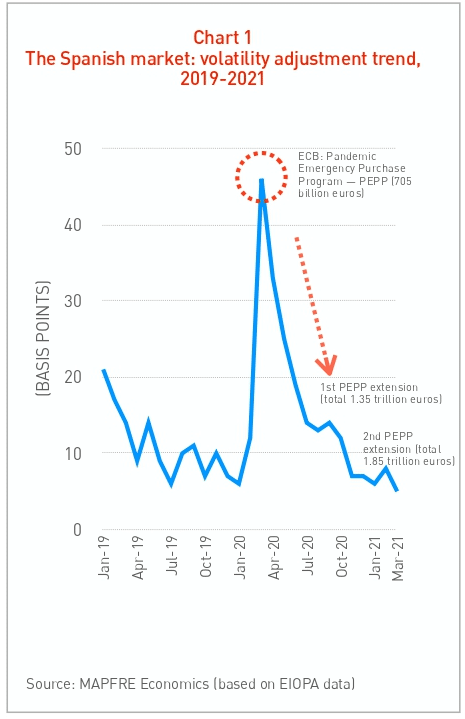
In March 2020, the currency volatility adjustment for the euro (calculated by the European Insurance and Occupational Pensions Authority (EIOPA)) reached the highest level that this indicator has seen since the Solvency II regulation came into force. This was due to the strong bout of volatility to which the investment portfolios of the insurance companies operating in the European Economic Area were exposed. The adjustment also reflects the powerful effect of the message launched by the European Central Bank on March 18, 2020 by approving the broad asset acquisition program called the “Pandemic Emergency Purchase Program (PEPP),” which involved resorting to the widespread use of unconventional monetary policy measures to provide liquidity to bond markets (sovereign and corporate), amounting to 750 billion euros, easing the maximum limits they can acquire from individual member states and between asset categories.
Subsequently, on June 4, 2020, the European Central Bank extended the maximum limit of acquisitions by an additional 600 billion to 1.35 trillion euros, which was reflected again in the indicator, at a time when it seemed to be changing trends. Finally, on December 10, 2020, the ECB again increased the limit on acquisitions by an additional 500 billion to 1.85 trillion euros, extending this extraordinary procurement program as long as necessary and at least until the end of March 2022.
Solvency ratios of Life insurance companies
The aggregate solvency ratio for the sample of insurance companies mainly operating in the Life line during 2020 was 234% (245% in 2019), which represents a decline of -11 pp compared to the previous year. Chart 2 shows the breakdown of solvency ratios for each of the insurance companies comprising the sample analyzed.
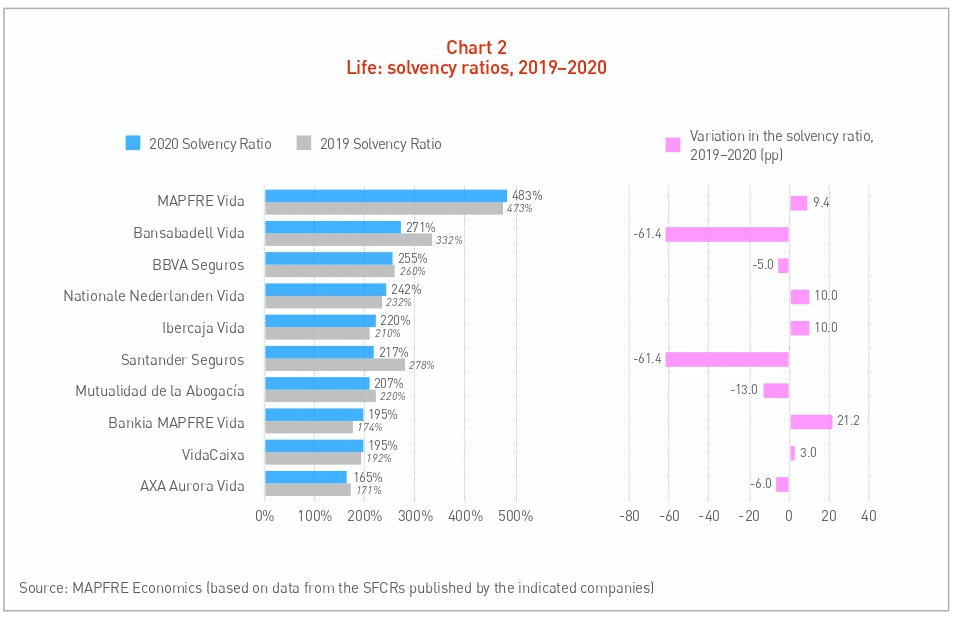
MAPFRE Vida still boasts the highest solvency ratio in this market segment, standing at 483% (9.4 pp higher than in 2019). The improvement in the Bankia MAPFRE Vida ratio (+21 pp) is also noteworthy. Apart from Bansabadell Vida (-61.45 pp), Santander Seguros (-61.44 pp), BBVA Seguros (-5 pp), AXA Aurora Vida (-6 pp) and Mutualidad de la Abogacía (-13 pp), the remainder of analyzed companies reported improved solvency ratios when compared to the previous year.
Chart 3 gives an idea of the weight that the effect of LTG measures on the solvency ratios of companies operating mainly in the Life line represents in the solvency ratio.
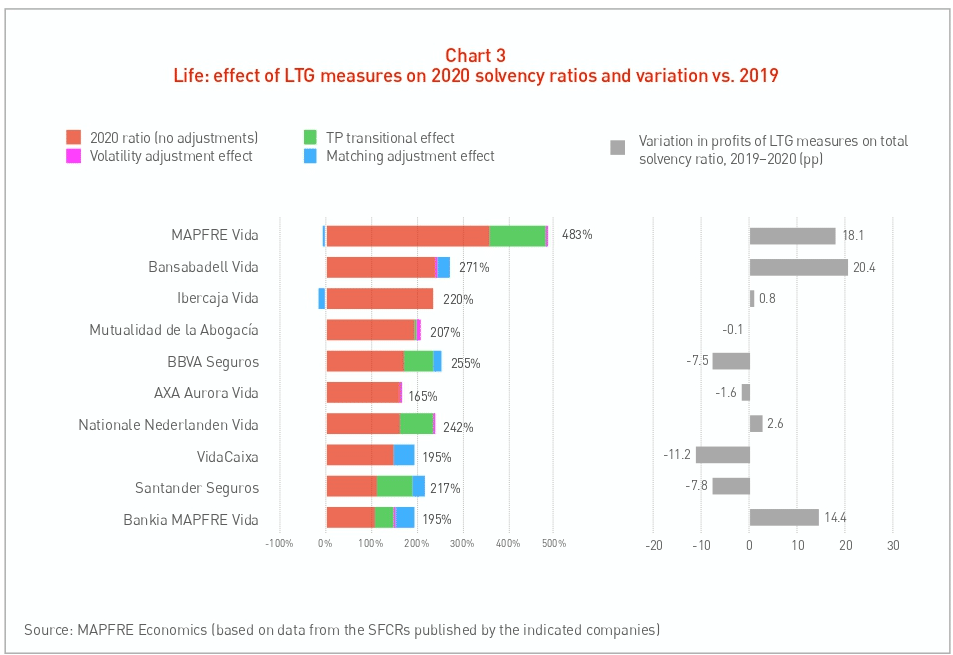
Solvency ratios of mixed insurance companies (operating in Life and Non-Life)
For the sample of companies considered in this report operating in both the Life and Non-Life insurance sectors (Composites), the total aggregate solvency ratio for 2020 was 216% (225% in 2019), a -9-pp decline compared to the previous fiscal year.
Chart 4 shows that, with the exception of Caser, the solvency ratio of the other composite companies fell compared to the previous year. The biggest setbacks were experienced by Santalucía and Catalana Occidente by -26 pp and -20.4 pp respectively. However, the solvency position of both companies remains strong at over twice the minimum required regulatory capital.
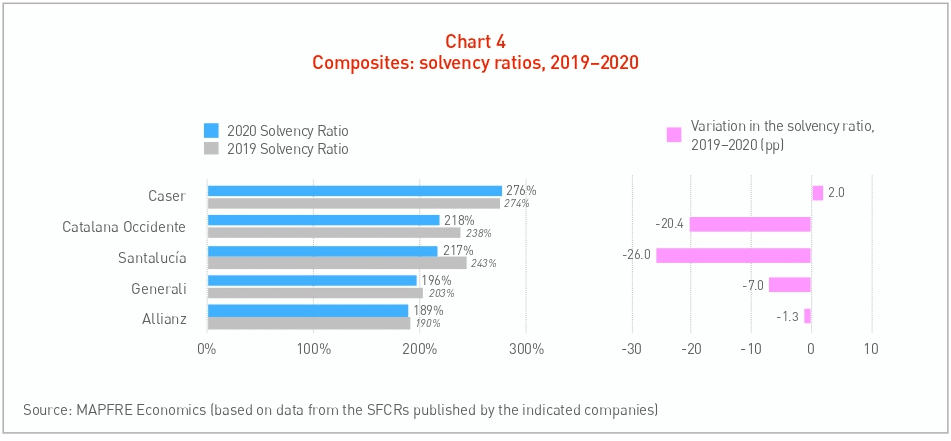
Chart 5 gives an idea of the weight that the effect of LTG measures on the solvency ratios of companies operating mainly in the Life line represents in the solvency ratio.
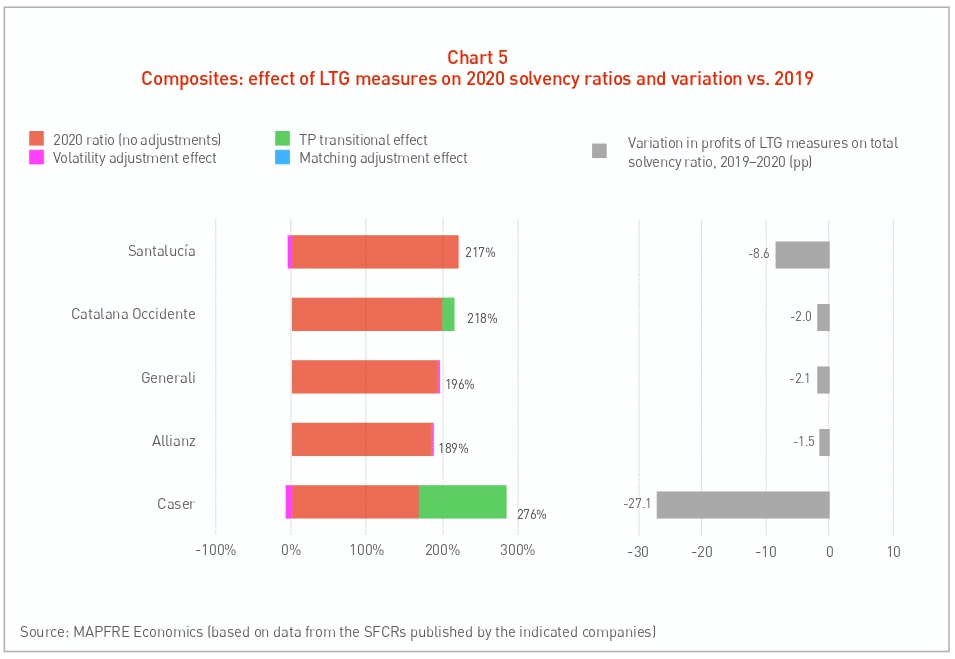
Solvency ratios of insurance companies operating in Non-Life
For the companies analyzed in this report operating solely or mainly in the Non-Life insurance sector, the total aggregate solvency ratio of the sample analyzed stood at 273% in 2020 (257% in 2019), recording a 16-pp increase compared to the previous fiscal year.
For this type of company, Chart 6 shows an overall improvement in the solvency ratio, the most notable of which was Asisa with 237% (+33 pp higher than in 2019), MAPFRE ESPAÑAwith 236% (+26 pp higher than in the previous year) and Mutua Madrileña with 464% (+26 pp higher than in 2019). Of the remaining companies, only two saw a reduction in their solvency margins: Ocaso, with a ratio of 272% (-32 pp compared to 2019) and SegurCaixa Adeslas, with a ratio of 154% (-1.5 pp compared to 2019).

For companies operating mainly in the Non-Life line, the effect of LTG measures on solvency ratios is not shown as this was practically irrelevant or null.
Relative weights of the different SCR risk modules
Chart 7 illustrates the relative weight of each of the risk modules forming the SCR (market risk, credit risk, underwriting risk and operational risks) for the group of insurance companies under analysis in this report in aggregate form. Likewise, said chart shows the positive effect of diversification in each case, as well as the positive impact of loss-absorbing capacity (LAC) of both deferred taxes and technical provisions for products involving profit-sharing schemes.
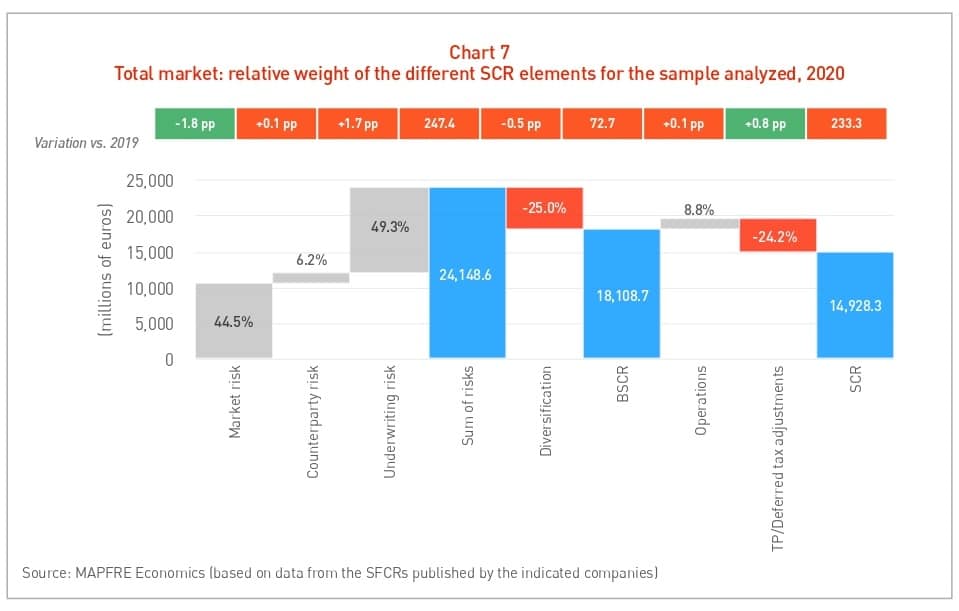
All companies in the sample use the standard formula to calculate their solvency capital requirement in all their modules, with the following exceptions: VidaCaixa, which applies a partial internal model for longevity and fatality risks; BBVA Seguros and MAPFRE Vida, which have a partial internal model for longevity risks; and SegurCaixa Adeslas and Sanitas, which use specific parameters to calculate their underwriting risk for medical expense insurance premiums.
Finally, Table 1 shows the relative weight that each of the risk modules that make up the SCR (market risk, credit risk, underwriting risk and operational risk) had in 2020 for each of the insurance companies considered in this report. This information also shows the positive effect of diversification in each case, as well as the positive effect of the loss-absorbing capacity of both deferred taxes (LAC DT) and technical provisions for products with discretionary profit-sharing schemes (LAC TP).





